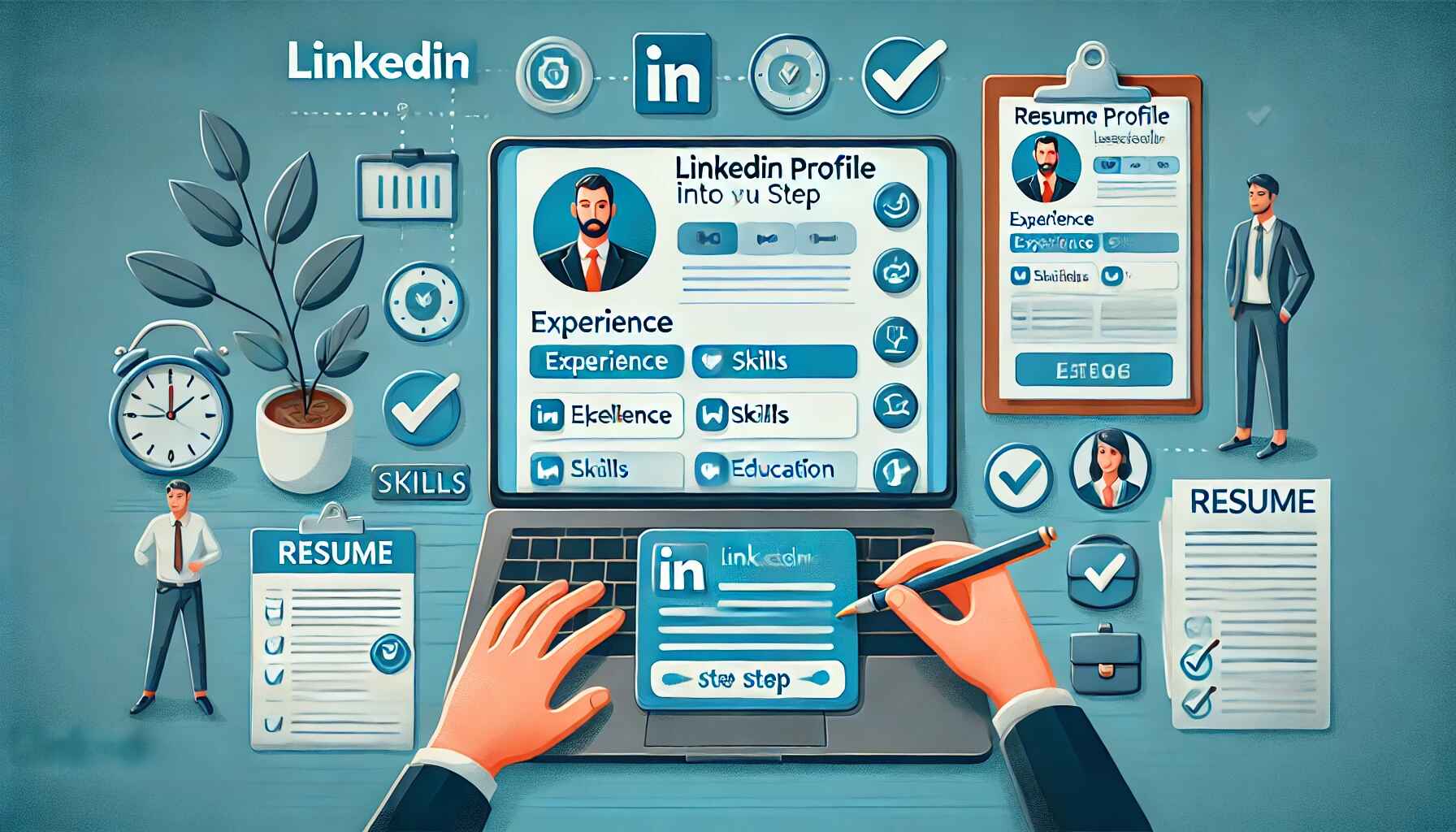How to Turn Your LinkedIn Profile Into a Resume: Step by Step
LinkedIn is not just a professional networking site; it's also a great resource to generate resumes. Your profile on LinkedIn is a digital copy of your professional life, and converting it into a resume saves time, organizes the job application process, and increases your opportunities for being noticed. Here's how you can easily turn your LinkedIn profile into a resume.
How to Convert LinkedIn Profile to Resume Step by Step
LinkedIn is more than a professional network site-it's a fantastic resume-making tool. A profile on LinkedIn is, in fact, a digital record of one's professional life. It saves time, rearranging the process of application for jobs and increases the chances of noticing you. This is how one can turn a LinkedIn profile easily into a resume.
Introduction to LinkedIn and its Role in Career Development
Linked-in has changed the way that an individual presents his skills, networking with industry peers, even finding a career. That's it, a living portfolio; it can also serve your resume. You can generate an effective and tailored resume from this because of the tools and the features of LinkedIn.
Why LinkedIn Matters in the Labor Market
LinkedIn is a go-to platform for recruiters and employers, often serving as a preliminary checkpoint before interviews. A well-maintained profile acts as your professional story, demonstrating your capabilities and potential.
Benefits of Using LinkedIn as a Resume Source
Converting your LinkedIn profile into a resume ensures consistency across your professional documents, highlights your key accomplishments, and simplifies the job application process.
Why Convert Your LinkedIn Profile into a Resume?
Versatility of a LinkedIn-Based Resume
A LinkedIn-based resume seamlessly converts into a resume for multi-job applications; thus, it is one versatile tool to have in your arsenal. And whether corporate roles or freelancing gigs or just internships, it will ensure that the story is presented coherently.
Saving Time and Effort through Profile Conversion
Instead of having to build from scratch, a LinkedIn-to-resume conversion will make use of the work already done in building and maintaining a professional profile. This is especially helpful when applying for several positions at once.
Preparing Your LinkedIn Profile for Conversion
To ensure a smooth transition from LinkedIn to resume, your profile needs to be polished and professional.
Optimizing Your LinkedIn Profile: Key Steps
Updating Your Professional Headline and Summary
Your headline should succinctly capture your expertise, while the summary serves as an elevator pitch highlighting your skills, achievements, and career aspirations.Highlighting Achievements and Skills
Use quantifiable metrics to showcase your accomplishments and include skills relevant to your target roles.Ensuring Consistency Across Sections
Avoid discrepancies between your LinkedIn profile and resume, especially regarding employment dates, job titles, and descriptions.
Using Keywords Effectively in Your Profile
Incorporate industry-specific keywords throughout your LinkedIn profile. Keywords help your profile stand out in search results and ensure that it aligns with applicant tracking systems (ATS).
Methods to Convert Your LinkedIn Profile into a Resume
Using LinkedIn’s Built-In Resume Feature
LinkedIn offers a straightforward "Save to PDF" feature. Here’s how to use it:
Go to your profile and click the “More” button.
Select “Save to PDF.”
A downloadable version of your profile will be generated.
While this method is quick, it might require some formatting adjustments for professional use.
Third-Party Tools and Software for Conversion
There are several online tools, like mycvcreator, Canva, or Resume Worded, that can transform your LinkedIn profile into a polished resume. These platforms often provide customizable templates for added personalization.
Manual Conversion: Tips and Tricks
If you prefer full control over the layout and content, manually convert your LinkedIn profile by copying relevant sections into a word processor or design tool. This method allows for greater customization and ensures alignment with specific job requirements.
Customizing Your Resume for Specific Jobs
Adapting for Industry-Specific Roles
Each industry values different skills and accomplishments. Tailor your resume to emphasize experiences and qualifications that resonate with your target role.
Tailoring for ATS (Applicant Tracking Systems)
To ensure compatibility with ATS, use simple layouts, standard fonts, and keywords from the job description. Avoid using excessive graphics or non-standard formatting.
Design and Formatting Tips for a Polished Resume
Choosing the Right Layout and Template
Select a clean and professional template that enhances readability. Templates from tools like Canva or Microsoft Word offer excellent starting points.
Highlighting Key Information Effectively
Prioritize information such as your contact details, professional summary, skills, and achievements. Use bullet points to make content scannable.
Common Mistakes to Avoid When Converting
Overlooking Profile Details
Ensure that your LinkedIn profile is up-to-date, and all sections are complete before converting it into a resume.
Neglecting Formatting Standards
Stick to standard formatting practices, including consistent fonts, aligned text, and a balanced use of white space.
FAQs About LinkedIn Profile Conversion
What Information Should I Include in My Resume?
Your resume should include contact details, a professional summary, work experience, education, skills, and notable achievements.Can I Use My LinkedIn Profile Without Adjustments?
While LinkedIn provides a solid base, slight adjustments are necessary to cater to specific job requirements.How Often Should I Update My Resume?
Update your resume whenever you change roles, complete a major project, or acquire new skills.Are Third-Party Resume Builders Effective?
Yes, third-party tools often offer user-friendly features and customization options.Do Employers Prefer Resumes Over LinkedIn Profiles?
Employers typically expect both; your resume serves as a snapshot, while your LinkedIn profile provides in-depth details.How Can I Ensure My Resume Stands Out?
Focus on achievements, use action verbs, and tailor it to the job description.
Conclusion: Streamlining Your Career with LinkedIn
Converting your LinkedIn profile into a resume is a time-saving strategy that aligns your professional documents. With a polished LinkedIn profile and a tailored resume, you can confidently tackle job applications and seize career opportunities.









